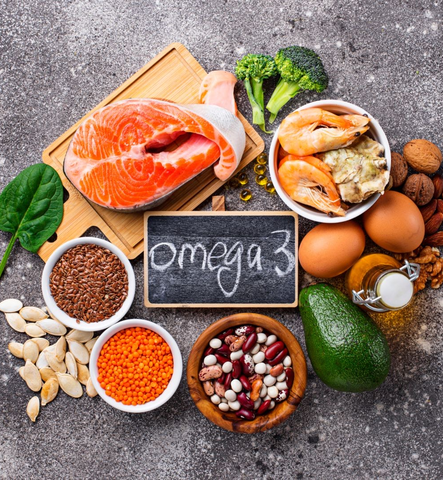What is Omega-3?
Omega-3 fatty acids (omega-3s) are polyunsaturated fats that perform important functions in your body. Omega-3 is an essential nutrient, which means that your body can’t produce the amount of omega-3s you need to be healthy, and so you need to get them from the foods you eat.
What do omega-3 fatty acids do?
Omega-3 fatty acids help all the cells in your body function as they should. They’re a vital part of your cell membranes and while they’re important to all your cells, omega-3s are concentrated in high levels in cells in your eyes and brain. Omega-3s also have important anti-inflammatory functions, can may be of benefit to people who have an inflammatory condition such as IBD. Omega-3s are also important to the production of hormones in our body, They play a critical role in a baby’s eye and brain development and so they are particularly important for pregnant women.
Omega-3s also have many potential benefits for your heart health. They help lower your triglyceride level, which is very beneficial for your cardiovascular health (heart and blood vessels). Omega-3s can also help increase your HDL (good cholesterol) and help to keep blood pressure under control. Omega-3s may help lower your risk of developing some forms of cancer, Alzheimer’s disease and an eye condition called age-relate macular degeneration. Ongoing research continues to investigate the role of Omega-3s in overall health.
Types of Omega-3
- EPA (eicosapentaenoic acid). EPA is a “marine omega-3” because it’s found in fish
- DHA (docosahexaenoic acid). DHA is also a marine omega-3 found in fish.
- ALA (alpha-linolenic acid). ALA is the form of omega-3 found in plant-based foods including flaxseed, walnuts, chia seeds and some leafy green vegetables such as kale and spinach.
EPA and DHA have greater health-promoting benefits than ALA. When you get ALA from food, your body is able to turn small amounts of the ALA into EPA (5-10%) and subsequently to DHA (2-5%). However, because these amounts are small, dietary sources of EPA and DHA (like fish) are the easiest and most reliable way to get the Omega-3 that you need.
How much omega-3 do we need?
Adults need about 1750mg per week of total EPA & DHA* – equivalent to 1-2 servings of oily fish, e.g. mackerel, herring, salmon, a week.
Pregnant women need an additional 700-1400mg DHA a week*. Pregnant women should remember to follow the food safety recommendations regarding fish (fish like tuna can be high in mercury). In general, fish is suitable for those with bowel problems such as IBS, IBD and FD. Frozen fish can be a cheaper, more readily available or handier option and is just as nutritious as fresh fish.
How to get enough omega-3 if you don't eat fish?
Many people do not eat fish for various reasons; they don’t like it, or choose to follow a plant-based diet (either vegan or vegetarian) for many different reasons. It can be more challenging, but not impossible to meet omega-3 requirements without fish. Only a small amount of plant-based omega-3, ALA, is converted into DHA and EPA.
American guidelines recommend 1.1g of ALA a day for women and 1.6g of ALA a day for men. However, you need to consume greater amounts of ALA if you don’t consume any EPA or DHA.
Here is the ALA content of some common foods, 8 walnuts = 2.2g, 1 tablespoon of flaxseed = 2.4g of, 1 tablespoon of chia seeds = 2.2g.
A vegan EPA/DHA supplement made from microalgae is often needed to meet requirements. Make sure that the supplement you are buying contains sufficient EPA and DHA, these are found on the label.
Omega-3 supplements- are they beneficial?
Omega-3 dietary supplements (fish oil pills) may have some benefits for select individuals. However some supplements, depending on their dosage, have also been reported to have side effects including diarrhoea or nausea and at very high doses have been associated with causing an irregular heart rhythm. The best way to get Omega-3 is through your diet. For those who don’t eat fish or who follow a vegan or vegetarian diet, this is entirely possible with some careful planning.
Omega-3s and you
Have a look at your diet to check if you’re getting enough Omega-3s. If not, try to look at adding some fish or increasing the plant-based sources to your weekly diet.



